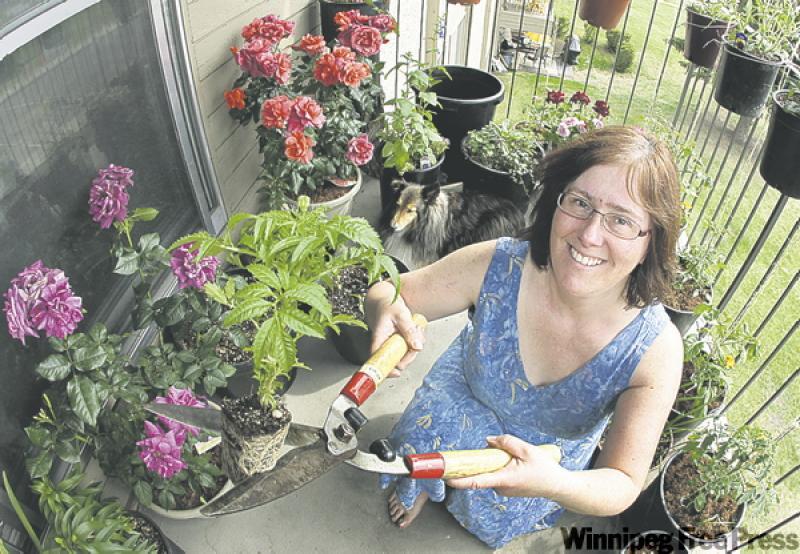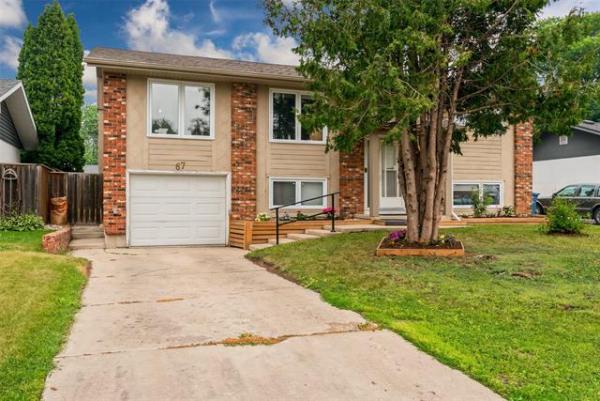No yard? No problem.
Just because you live high in the sky doesn't mean your green thumb has to go brown.
While balcony gardening comes with its own unique challenges, the lawnless can easily turn patios into lush escapes with just a little planning.
Kim Schaeble, is an expert gardener with a west-facing balcony that gets lots of sun.
Anna Krupnik-Boudreau just moved into her south-facing apartment a few months ago, and is balcony-gardening for the very first time.
We find out what the two have going so far, and what they have planned.
Kim Schaeble:
Balcony: Five feet by 10 feet; facing west, on the third-floor of a walk-up.
Challenges: Limited space and no shade.
"I have to make sure I get plants that are very hardy or take care to water every day, sometimes twice a day,"Schaeble says.
Last year, she had a whitefly problem because her balcony was too crowded.
Plants: This season, Schaeble is growing a whopping two dozen varieties of plants, including roses, marigolds, five varieties of tomatoes, watermelon, potatoes, strawberries, Swiss chard, catnip (for her grey tabby, Ciaran), sweet bell peppers, carrots, petunias, lavender, dahlias, geraniums, cucumbers, citronella, and three herbs.
While Schaeble has to stay away from shade-loving plants, she couldn't resist growing coleus and fuchsia in a slightly darker corner of her balcony.
Plan: Schaeble has divided her balcony into three tiers: the majority of her taller tomato plants and root vegetables are on the balcony floor, while sweet-scented flowering plants are attached to her balcony railing for easy sniffing. Bushy, flowing vines hang from the ceiling.
Other than that, Schaeble plans to let her garden grow with the flow. "I like to be surprised."
Schaeble started gardening on her balcony in 2005, and her efforts haven't gone unnoticed. Once in full bloom, the 44-year-old's floral oasis can be difficult to miss.
Schaeble likes to experiment with new plants every year and play around with different mixes of veggies, fruits and annuals.
"I've learned to build my little five-foot-by-10-foot balcony quite full so it looks like a little garden,"she says. "When I come home... I can look up at my apartment, especially when it's full of flowers and full of colour, and go 'Wow, look at that.' "
Anna Krupnik-Boudreau:
Balcony: 12 feet by 12 feet; facing south, on the second floor of a townhouse.
Challenges: Lots of wind and sun.
"We do get full sun all day," Krupnik-Boudreau says. "Spinach will bolt if it gets too hot. It grows really, really fast in a short time and it goes to seed and becomes bitter."
To combat the heat, Krupnik-Boudreau waters a few times a day and has bought special vegetable food from Home Hardware to feed her plants.
Plants: Tarragon, rosemary, spinach, romaine, green and red-leaf lettuce, basil, flat-leaf parsley, thyme, and chives in rectangular rail pots.
"I grew up on a farm with a huge garden, and to me, gardening means growing food, not decorations," Krupnik-Boudreau says. "Flower gardens were just extra, once the 'real' garden was taken care of."
Plan: "My main goal is, I want to have a lot of edibles,"Krupnik-Boudreau says. " You buy your fresh salad in the grocery store and it goes bad so quickly. It's such a waste. So if I grow it myself, I don't have to worry about it. I can just snip it when I need it."
-- Canwest News Service
Tips based on experience:
In four years spent gardening on her balcony, Kim Schaeble has amassed a lot of wisdom through trial and error. Here, she shares her best tips:
Pots used to grow tomatoes should be two gallons or larger. "Tomatoes require regular watering at the same time every day, so with the smaller pot I had to water at least twice a day just to keep up."
Plant a marigold with each tomato. This encourages beneficial insects to pollinate your plants.
Grow tomatoes on a string, using plant clips. This saves space and the plants won't blow over as easily in strong winds.
Use a tall, wide pot to grow potatoes. Place some soil in the bottom, add the seed potato, and cover with an inch or two of soil. Each time the potato plant grows a few inches above soil level, bury it with another layer of soil. Repeat until you reach the top of the pot. Then let nature take its course.
Rotate pots once a week or so, changing their locations occasionally. Turning the pots (an advantage impossible in a garden bed) encourages growth in all directions. Rearranging the pots changes how much sun each gets. "Remember that each plant, especially a healthy, large plant, is going to create shade for plants behind or beside it."
Don't plant onions and garlic in the same pot. Onions inhibit garlic's growth.
Prepare nutrient-rich water for your plants, which don't get as much nourishment in containers as they would in the ground. Schaeble lets tap water soften for a day before adding just enough fertilizer to change its colour. She uses the mix to water her plants.




